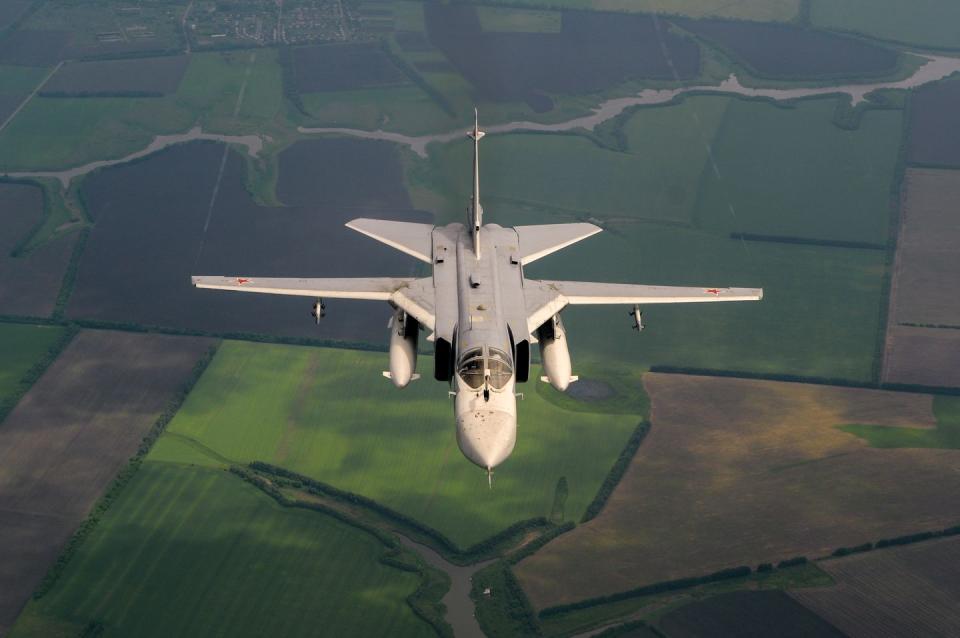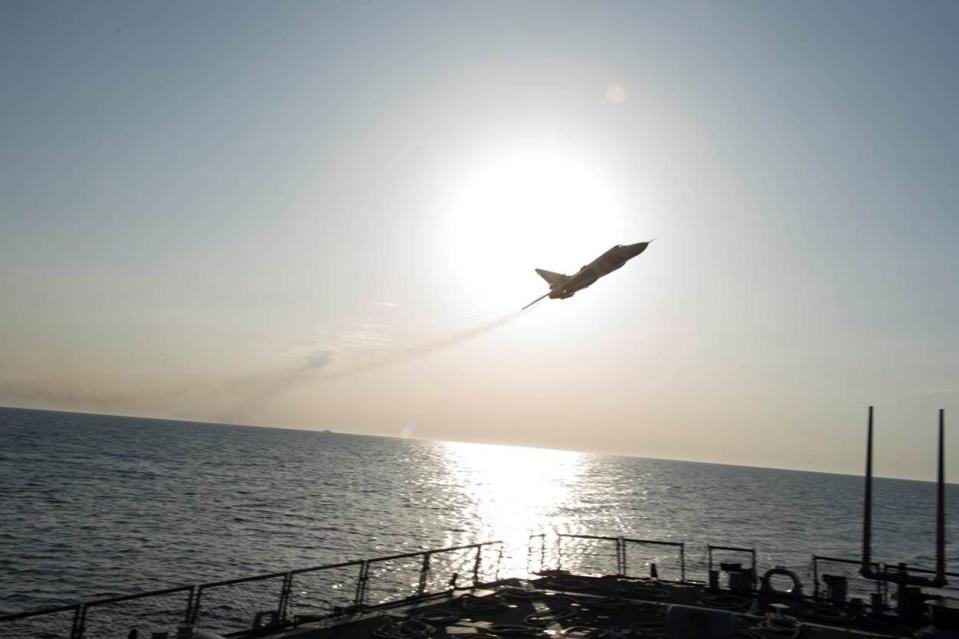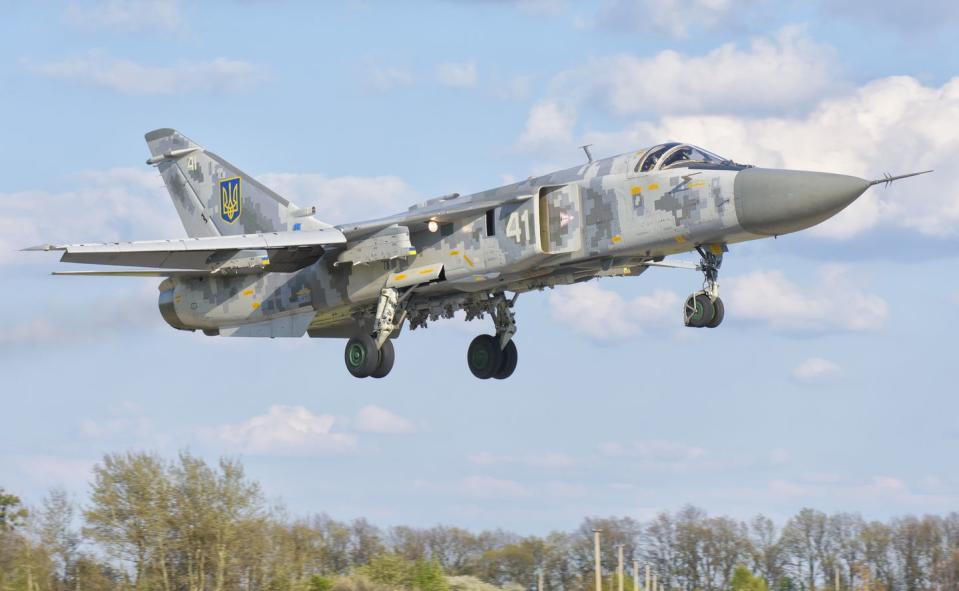Guerilla Arsonists Just Set Fire to Russia's Supersonic Bomber

Russian President Vladimir Putin’s invasion of Ukraine has been tough on Russia’s inventory ground attack aircraft, with photos confirming at least 60 of its Sukhoi bombers and attack jets destroyed or heavily damaged by early May 2020. And a recent incident suggests even those deployed thousands of miles away from Ukraine may still be in the line of fire.
On May 8, just prior to Russia’s Victory Day holiday, saboteurs filmed themselves setting fire to one Su-24 supersonic bomber parked near some woods by the Sukhoi aircraft factory at Novosibirsk—located 1,800 miles east of Ukraine in Siberia. The Novosibirsk Aircraft Production Association Plant there is engaged in producing the Su-24’s successor, the Su-34 Fullback bomber.
A video was published where Russian partisans claim to have destroyed a SU-24 combat aircraft in Novosibirsk.
The aircraft was located at the site for repairs and modernization. That won't be necessary now, it seems. pic.twitter.com/od5bGy9cqi— Anton Gerashchenko (@Gerashchenko_en) May 9, 2023
This video was posted on the social media account of the Freedom of Russia Legion, officially a unit in in Ukraine’s Territorial Defense Force composed of Russian volunteers and defectors who view themselves as opponents of Putin’s regime. The account described the saboteurs as “unknown partisans” and “guerillas.”
They allege that this Su-24 was set to undergo upgrades and refurbishing, presumably for potential combat use. At least two other bombers (seemingly Su-34s) can be briefly glimpsed parked next to the Su-24.
The social media post claims the Su-24 was “successfully burned down,” although that can’t be verified from the video itself.
Subsequently, the Baza news account on Telegram reported that, in reaction to the video, a local policeman located the “mothballed” Su-24. It was described as “...not particularly damaged, but the chassis clearly showed traces of flammable liquid burning.” The report states the saboteurs cut through a chain link fence and were recorded on security cameras.
It’s possible this aircraft was one of a few Su-24MKs (a downgraded export model) that have been seen in satellite photos parked at the factory for over a decade awaiting a buyer.
2/which is very unfortunate.
The date on the sat image doesn't matter, trust me, those Fencers are rotting there for a long time. There were 3 of them at first since 2011, stored under neat covers, awaiting a delivery to a foreign customer that never went through (Libya?). pic.twitter.com/F1w56V7qCU— LotA (@LotA_IL) May 9, 2023
Russia has a fairly deep inventory of Su-24s. Flight Global estimates that Russia’s tactical aerospace force, the VKS, retained 220 in 2022. Only a limited number have been committed to the battle in Ukraine, unlike the newer Su-34s.
Suspicious Fires
The Freedom of Russia Legion is reportedly involved in arson and other sabotage actions in Russia, as well as reportedly dispatching troops to support Ukraine’s military in battle in Eastern Ukraine. However, Russian sources, and even some Ukrainian ones, express doubt that its claimed two or three battalions exist in such numbers. Nonetheless, Russian authorities have arrested and imprisoned multiple individuals for allegedly attempting to join the Legion.
The Su-24 burning follows a series of other incidents involving the sabotage of aircraft well inside Russian territory. This includes an incident on November 1, 2022 in which three advanced attack helicopters—two Ka-52 Hokums and a Mi-28 Havoc—were destroyed at Veretye airbase in the Pskov Region, 400 miles away from Ukraine
More recently, on March 3, opposition in Belarus reportedly used quadcopter drones to sabotage the radar-dome of a rare A-50 airborne early warning aircraft.
And finally, on March 13, an Su-27 fighter of the 22nd Fighter Aviation Regiment was set ablaze in Artyom, 4,000 miles east of Ukraine, in a fashion very similar to the May 8 attack.
«Unknown partisans near Vladivostok burned Su-27 at the Tsentralnaya Uglovaya airbase in the city of Artyom , where the 22nd Aviation Regiment of Russian Aerospace Forces is based.» - from the media of the “Freedom of Russia Legion” https://t.co/suxC6Zqwpa pic.twitter.com/7lBlDc5gYV
— Special Kherson Cat 🐈🇺🇦 (@bayraktar_1love) March 10, 2023
These episodes highlight the poor security (lack of guards and fences) around many Russian military aviation facilities. And they seem likely to continue.
Cold War Fencers Over 21st Century Ukraine

The Su-24, codenamed ‘Fencer’ by NATO, is a Cold War two-seat supersonic bomber with a maximum speed of Mach 1.6. and swing-wings, which allow it to optimize flight performance for either low or high speed handling.
Entering service in 1974, it was designed to penetrate air defenses by flying very low to minimize radar detection time, aided by a terrain-following radar system that automatically corrected course to avoid crashing. All these characteristics made it conceptually similar to the U.S. Air Force’s F-111 Aardvark bomber, operated from 1967-1996, though with shorter range.
The twin-engine Su-24 could carry nearly nine tons of bombs, rockets, or missiles on nine hardpoints (including tactical nukes) supplemented by a 23-millimeter rotary cannon. Russia’s tactical air force—the VKS—still operates the twice-modernized Su-24M2 model (Fencer-D), which has aerial refueling capability, support for diverse TV-, laser- and radar-homing guided weapons, digital cockpit displays, and the Gefest satellite-navigation bombing system used to enhance accuracy of unguided bombs.
Despite these trimmings, the M2 model’s capabilities remain limited by its outdated Kaira-24 laser/TV targeting system, which is only useable during the day in clear weather and can’t target satellite-guided weapons.
The VKS also retains Su-24MR tactical reconnaissance jets (Fencer-Es) which trade weapons for panoramic cameras, IR sensors and ground-scanning, side-looking radars. These were extensively used starting a few weeks prior to Russia’s invasion to map targets along the border that were subsequently bombed by Su-34s at the beginning of the war.
The Russian Navy’s 43rd Naval Attack Aviation Regiment, based at Saki on the Crimean peninsula, also retained around 22 Su-24Ms.

While newer Su-34 bombers, derived from the Flanker family of fighters, have been at the forefront of combat over Ukraine, Russia’s Su-24M2s began playing a supporting role after sitting out the first month of the war. And they’ve taken their share of lumps, with evidence confirming nine destroyed and two damaged, the majority by artillery and drone strikes targeting airbases in Kherson and Saki.
The notorious Wagner Group has also been allowed to have mercenary pilots operate these older bombers in support of its ground forces—one was lost over Bakhmut and another was heavily damaged by a Piorun portable missile. In a publicity stunt, Wagner’s leader Prigozhin even recorded himself on combat mission in the navigator’s seat of an Su-24.

Ukraine’s air force also began the war with an estimated 15 to 20 Su-24Ms in its 7th Bomber Regiment. On the war’s first day, two Ukrainian Fencers cratered the runway of Hostomel airport after it was seized by Russian paratroopers, helping prevent landing of reinforcements intended to capture Ukraine’s capital of Kyiv.
Photo: Ukrainian jet flying at low attitude and provides support for Ukrainian troops during the counter-attack on #Hostomel airfield pic.twitter.com/JK31VwuYD9
— MilitaryLand.net (@Militarylandnet) February 24, 2022
However, Ukraine’s Su-24 fleet has suffered terrible losses to Russian fighters and air defenses, with at least 17 craft confirmed destroyed. Still, the UAF has apparently managed to expand its Su-24 inventory, drawing from as many as 47 Fencers reportedly stored in decent condition pre-war.
Thus, Ukrainian Su-24s continue to be recorded on combat missions, sometimes armed with Kh-25ML laser-guide missiles and accompanied by fighter escorts. And as Ukraine receives heavy, long-range air-to-surface weapons from Western states, it could possibly adapt some of its remaining Fencers to serve as launch platforms.
You Might Also Like
